| |
Real-world safety of pre-exposure prophylaxis for HIV - Comment
|
| |
| |
March 07, 2022 Charles M Burns, *Christina Wyatt
Download the PDF here
Download the PDF here
In the decade since it was first approved, tenofovir-based pre-exposure prophylaxis (PrEP) has emerged as one of the most effective means of preventing the spread of HIV.1, 2 However, PrEP remains underused3 and PrEP users tend to disengage from care over time.4 There are many potential barriers to PrEP use in real-world settings, including associated costs to patients and clinics, the need for frequent follow up, and concerns about potential side-effects. Addressing these barriers might make PrEP more accessible to people at risk for HIV transmission as we work towards ending the HIV epidemic.
One barrier to PrEP implementation is the need for frequent monitoring of creatinine clearance due to the potential for kidney toxicity with tenofovir disoproxil fumarate. The WHO 2017 implementation tool for PrEP recommends obtaining blood creatinine every 6 months in all users of tenofovir disoproxil fumarate-based PrEP.5 In The Lancet HIV, Robin Schaefer and colleagues6 evaluated the effect of tenofovir disoproxil fumarate-based PrEP on kidney function in a real-world setting. The authors did a systematic review and meta-analysis of published literature as well as a meta-analysis of individual participant data from 17 PrEP implementation projects and two randomised controlled trials including longitudinal data from 14 368 PrEP users. Although tenofovir disoproxil fumarate-based PrEP was associated with increased risk of grade 1 and 2 or higher kidney adverse events, clinically significant declines in creatinine clearance of less than 60 mL/min were rare and occurred more commonly with increasing age and in people with baseline creatinine clearance of less than 90 mL/min. The increase in risk was most significant for people older than 50 years but was also notable for those older than 40 years. Important caveats acknowledged by the authors include a lack of data on PrEP adherence and relatively short follow-up (median 10 months, IQR 6-15, range 0-51). Highly adherent PrEP users had the greatest benefit but might also be at increased risk for kidney injury and other adverse effects of PrEP, particularly with long-term use. Longitudinal data were also more limited for women, with cisgender men making up more than three-quarters of the participant level meta-analysis sample.
We believe these findings help to identify subgroups that will benefit most from intensive monitoring of kidney function when taking tenofovir disoproxil fumarate-based PrEP. With the recent approval of monthly cabotegravir for PrEP, these data also identify subgroups of PrEP users who might be better candidates for alternative forms of PrEP, including cabotegravir or emtricitabine with tenofovir alafenamide when available. However, the access too, and indications for, these alternative PrEP medications are limited. In turn, perhaps the recommendations for creatinine testing can be relaxed for younger patients with normal baseline kidney function, who are at low risk of PrEP-associated kidney toxicity. Reducing barriers to PrEP use among younger individuals would be especially beneficial because globally 82% of new HIV infections in 2020 occurred among people aged 15-49 years.7 If we can target the subgroup of PrEP users who would benefit most from frequent creatinine testing this might reduce the cost, infrastructure, and frequent follow-up visits required for PrEP care. As a result, the barrier to entry into PrEP care and retention in PrEP care might be reduced for young healthy people at risk for HIV.
The results of Schaefer and colleagues have immediate implications for clinical practice and health policy. Clinicians can use these findings to discuss the small risks associated with tenofovir disoproxil fumarate-based oral PrEP with clients and advise clients on available PrEP options when available in their location. PrEP providers should revisit the risks and benefits with PrEP users who remain adherent to PrEP for periods longer than 12 months, given the paucity of data beyond that point. Similarly, these findings might lead to a change in the recommended frequency of laboratory testing in future PrEP treatment guidelines. The results of this study support the updated PrEP guidelines from the US Centers for Disease Control and Prevention, which now recommend creatinine clearance monitoring every 6 months only for people aged 50 years or older or with creatinine clearance of less than 90 mL/min at PrEP initiation, and every 12 months for other PrEP users.
8 Using real-world data to shape future PrEP programmes is an important step towards increasing PrEP accessibility and preventing the spread of HIV.
--------------------------
A RETROSPECTIVE ANALYSIS OF BONE LOSS IN EMTRICITABINE/TENOFOVIR THERAPY FOR HIV PrEP
Higher cumulative TFV/FTC levels in PrEP associated with decline in renal function
Older Age Associated with both Adherence and Renal Decline in the PrEP Demo Project

March 2022 Lancet
After controlling for age and gender, baseline creatinine clearance was the strongest determinant of risk of a creatinine clearance of less than 60 mL/min after PrEP initiation, which has also been reported elsewhere.
Most individuals who had a clinically significant decline had a baseline creatinine clearance of 60⋅00-89⋅99 mL/min.Risks of declines in estimated creatinine clearance were low for all genders, but we found slightly higher risks among cisgender women than cisgender men. In our study, the higher risk among cisgender women might have been an artefact of the PrEP dosing regimen, because men in our dataset were more likely to live in HICs where event-driven PrEP was offered. Previous studies have found a dose-response relationship between tenofovir disoproxil fumarate exposure and declines in creatinine clearance, suggesting that lower tenofovir disoproxil fumarate exposure of event-driven PrEP might have a comparatively better kidney safety profile. Data on adherence to oral PrEP were not available and a dose-response relationship between PrEP use and effects on kidney function could not be evaluated. Moreover, effects of oral PrEP use on kidney function might only present themselves after a prolonged period of use. In our study, sizable numbers of individuals were lost to follow-up shortly after initiation, although nearly 6000 participants had at least 12 months of follow-up. There was a trend of decreasing proportions of individuals with declines in creatinine clearance with increasing time of follow-up, with similar patterns in LMICs and HICs. However, this trend might be a form of survival bias, with individuals having adverse events discontinuing PrEP shortly after initiation. The loss-to-follow-up after PrEP initiation limits evaluations of longer-term effects of oral PrEP use on kidney function. Nevertheless, this loss-to-follow-up reflects patterns of PrEP use observed in many settings, with PrEP users commonly discontinuing shortly after initiation. Using PrEP during periods of risk reduces overall tenofovir disoproxil fumarate exposure and thus risks of kidney-related adverse events.
Proportions of individuals with a decline in estimated creatinine clearance to less than 60 mL/min increased by age (figure 3). The median age of
those who had such a decline was 40 years (IQR 34-51). After controlling for gender and baseline creatinine clearance stage, those older than 50 years had a significantly higher risk of a clinically significant decline in creatinine clearance (adjusted hazard ratio [aHR] 6⋅05, 95% CI 1⋅41-26⋅0; appendix p 11).
Of the 349 individuals who had a clinically significant decline, 254 (72⋅8%) had a creatinine clearance of 60⋅00-89⋅99 mL/min at baseline and 79 (22⋅6%) had a creatinine clearance of 60⋅00-69⋅99 mL/min; 7⋅16% had a baseline creatinine clearance of less than 60 mL/min (those with a baseline creatinine clearance of <60 mL/min were only counted as a decline it they had ≥60 mL/min at a subsequent visit). After controlling for age and gender, there was an eight-fold increase in the risk of a clinically significant decline among those with a baseline estimated creatinine clearance of 60⋅00-89⋅99 mL/min (aHR 8⋅49, 95% CI 6⋅44-11⋅20) and a 20-fold increased risk among those with less than 60 mL/min than those with a baseline of 90 mL/min or more (aHR 20⋅83, 12⋅83-33⋅82; appendix p 11).
lthough not statistically significant, cisgender females tended towards an increased risk of a clinically significant decline (aHR 2⋅43, 0⋅98-6⋅00). A decline to less than 60 mL/min was reported in 136 (4⋅55%) of 2992 cisgender females, compared with 211 (1⋅90%) of 11 131 cisgender males. However, 90% of the cisgender women with a creatinine clearance of less than 60 mL/min (n=123) came from two projects in India (Ashodaya Samithi) and Eswatini (FHI 360) that contributed 662 (22⋅1%) of 2992 women included in the longitudinal analysis. When excluding these two projects, no difference in risk between cisgender women and men was observed (aHR 1⋅12, 0⋅38-3⋅32), and effects by age and baseline creatinine clearance remained the same (appendix p 12). The effect was also reduced when limiting analyses to LMICs (aHR 1⋅64, 0⋅64-4⋅19; appendix p 11). There was no risk difference between cisgender and transgender or non-binary individuals, although data were scarce (appendix p 11). Data on comorbidities were too scarce to be included in regressions.
Figure 3. Cumulative probability of maintaining an estimated creatinine clearance of 60 mL/min or more over time after PrEP initiation in PrEP users from 15 countries by age group (A), gender (B), and baseline estimated creatinine clearance (C).


|
|
| |
| |
|
|
|